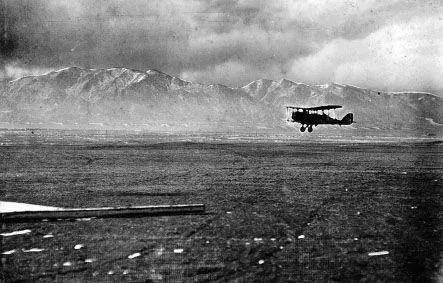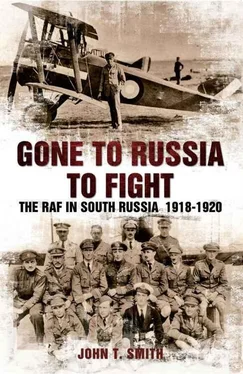The commander of 62 Wing, Lieutenant Colonel Bowhill, began his journey to Petrovsk to take command early in February. Bowhill was described by Lieutenant C. N. H. Bilney in the following terms:
…a shortish red faced man with bushy ginger eyebrows, outwardly a little brusque but with a heart of gold and a great gift of leadership’. [1]
Bilney was travelling with Bowhill as baggage officer to the headquarters staff, but his real job was to get the seaplane base at Petrovsk ready for 266 Squadron, who would be arriving later with the Short 184 seaplanes. The commander of 266 Squadron was to be Captain J. A. Sadler, as he recorded in his log-book on 1 February:
Took command of 437 Flight (Russian draft changed to 266 Squadron – 62 Wing). [2]
The two flights in 266 Squadron were 437 and 438, both stationed on Mudros in the Mediterranean. Bowhill and the wing staff left Lemnos in the middle of February on board the Princess Ena , an old Channel Island ship.
The ship stopped in Constantinople and the RAF men had a short time ashore, where Bilney managed to buy some cartridges for his home-made shotgun. Following the same route as 221 Squadron, the ship arrived in Batum after a rough crossing of the Black Sea. Bilney was less than impressed by his first view of Batum:
We eventually arrived at Batum which was a depressing sight, absolutely run down, completely. There were piles of manganese ore on the quays awaiting export, but nothing to export it in and everything was derelict. [3]
The party travelled across the Caucasus by train, along with four of the naval CMBs:
On a cold afternoon we left Batum and started out on what turned out to be a six day journey… It was very cold, and soon after leaving Batum we picked up snow which remained with us for the rest of the journey, in depths of up to 4 ft… A lot of the country [along the Caspian] was flat and uninteresting but where the hills came down to the sea we had to cross valleys and though many of them were beautiful we did not enjoy them much as valleys meant bridges and most of these had been burnt during the fighting. From a truck you have a view vertically downwards, and just looking at the charred ends of sleepers between you and the valley bottom was not very reassuring. [4]
While Bilney and Bowhill were travelling towards Petrovsk, 221 Squadron had started operations against the Red Army. The squadron diary states that four DH9s flew the first combat operation on 3 February. Bombs were dropped on the towns of Kalinovskaya and Kizlyar. Grozni was seen to contain at least 1,000 cavalry, and at Shedrinskaya an armoured train was bombed and machine-gunned from 2,000 ft. The train fired back and the DH9 was hit. On 5 February, Grozni was again bombed:
Grozni attacked by one DH9. Barracks attacked with eight 16lb. bombs and 144 baby incendiary. Fire caused and many hits observed on buildings. Troops of horsemen with Red Flag attacked and dispersed with machine gun fire N.E. of town. Many casualties observed. Rolling stock for ten trains at station. [5]
During the day, Naurskaya was also bombed, and on the rail line a train was bombed by a DH9. A direct hit was obtained with two 65 lb bombs, destroying four trucks and partially derailing the train.
On 5 February, the advancing White forces captured Grozni. The cavalry that was attacked north-east of Grozni may have been White cavalry. Noting this incident in his diary, Knock wrote:
Two Nine Acks [DH9As] go on reconnaissance North each with two 65 and one 230 pound bombs. South of Astrakhan they spot a parade of cavalry, with red pennons flying. Drop the pills and get photos. Return and develop in glee showing much carnage. One up against the Reds.
13/2/19 Cossack officer of high rank arrives with interpreter. Story gets round. That was no Red cavalry bombed, but the side we are supposed to be assisting. Our ’planes decimated a squadron of White cavalry. WT man tells me that SNO [Senior Naval Officer] Caspian has ordered 221 to cease activity until further orders. Thought that Cossack looked furious. No wonder. [6]
There is no mention of this incident in the squadron records or the squadron diary. If it did actually occur, Knock does not seem to have been too bothered.
The rank and file of the RAF force had not volunteered for duty in Russia and now that the ‘real’ war against Germany was over, most of them just wanted to get home. They had no real understanding of the issues involved, or even the forces involved, or what they were doing stationed at a port on the Caspian Sea. Some of them were not even sure what side they were on. Knock had earlier written:
5/2/19 Realise that we are actually attached to Denikin’s White Army here. [7]
It is always a good idea in war to know whose side you are on.
On 8 February, Major Andrews flew a reconnaissance in his personal Camel, looking for advanced landing strips, but none were found. Describing the first week’s operations, the squadron diary states:
The weather for the week has been bad, high winds, mist and low clouds. The attacks on the 5th made on trains, barracks, etc. were very successful and were carried out from low altitudes with skill and daring, in spite of heavy barrage of rifle and machine gun fire. The machines were hit frequently and two were forced to descend about 50 miles away from their aerodrome, owing to damage due to enemy fire. One crashed badly on landing, the other was burnt by the pilot to prevent it falling into enemy hands. Pilots and observers managed to return safely to the aerodrome. [8]
The loss of two aircraft out of the three involved shows the extent of the ground fire the DH9s had faced.
During the rest of the month, the weather continued to be bad, only allowing the occasional operation. On 9 February, a reconnaissance was carried out along the rail line that runs north-west towards Ekaterinodar and had just been captured from the Reds. The DH9 carried a British engineering officer as a passenger. Another reconnaissance was carried out north along the coast on 15 February. Three DH9s bombed a Red ship trapped in the ice on 18 February. Only one direct hit was obtained. The crew escaped across the ice and were machine-gunned by one of the DH9s.
The DH9s did not have the range to bomb Astrakhan from Petrovsk. On 22 February, a DH9 reconnoitred Chechen Island, looking for an advance landing ground to shorten the distance to Astrakhan, but nothing was seen owing to the bad weather. For the rest of the month, only a few practice flights were carried out. The squadron diary states:
Owing to the advance of the Volunteer Army and the fact that there is no Liaison Officer now with them, no bombing for this Army could be carried out as their movements are uncertain. [9]

A DH9A landing at Petrovsk airfield. Note the Caucasus Mountains in the background, the highest mountains in Europe.
The Volunteer Army had joined forces with the Terek Cossacks and was driving the Red Army back towards Astrakhan.
The conditions in Petrovsk were extremely unsettled. British troops were told only to go out in pairs and to avoid certain parts of the town. Lieutenant L. H. Kemp, with the RAF contingent, wrote about the situation:
We had a lot of incidents really. We were billeted in a school and the odd bullet would fly past the window at night. [10]
A number of Army personnel were killed in Petrovsk during the British time there and their killers were never found.
D. B. Knock seems to have settled in better than some of the officers:
15/2/19 Make a friend in one Waldemar Zagorsky Russian non-com, pilot attached to us. Shows me the ropes in Petrovsk Port and we have much fun together. He speaks French. I teach him English and he responds with Russian. Getting things off fine now. Can hold almost a normal conversation in Russian. Waldy can hold his vodka and shows me how! Introduces me to Zenia, sister of lady friend. [11]
Читать дальше













